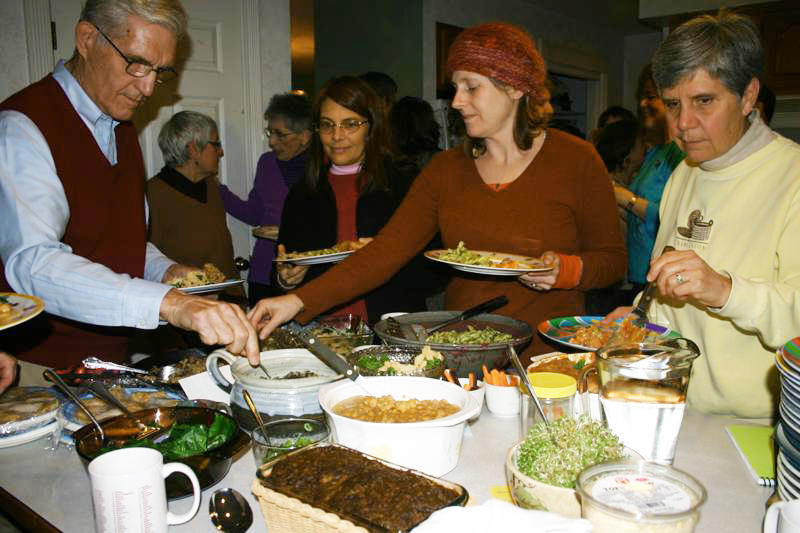Most potlucks feature an assortment of cheese and meat-heavy casseroles, causing vegetarians like me to count ourselves lucky if there’s a lone green salad we can enjoy.
But during the monthly macrobiotic potluck held Friday at the Portland home of Amy Rolnick and John Williamson, I was thrilled to find dozens of dishes without a hint of animal products in sight.
I loaded up my plate with a delicious assortment of barley, gingered chickpeas, steamed collard greens, azuki beans and squash, cabbage with poppy seeds, spring rolls, tofu salad, alfalfa sprouts, udon salad with sesame ginger sauce, pesto pasta, and lasagna made with tofu filling and a carrot-beet sauce.
These monthly get-togethers started in 1997 when a group of students in Lisa Silverman’s macrobiotic Five Seasons Cooking School decided they should enjoy some grub outside of class. The potlucks have been going strong ever since.
“It’s really cool, because if you want to embrace this style of cooking, you can find out what you like and don’t like,” said Sarah Coupe, who’s been to a handful of the gatherings, which move around each month to a different person’s home.
In addition to trying new foods, the potlucks offer an opportunity for those who attend to share cooking tips and spread the word about macrobiotic happenings in the community. Most feature a talk or a demonstration, and to that end, Rolnick showed the group how simple it is to create fresh sprouts with a glass jar, a bit of mesh and a sprinkling of organic seeds.
While macrobiotic cooking has much in common with vegan food preparation, it’s not the same. Macrobiotics is both a philosophy and a cooking style that aims to create a healthy mind and body. The foundation of the diet is cooked whole grains, which are complemented by vegetables (particularly leafy greens), beans and sea vegetables. On occasion, those who follow a macrobiotic diet eat fish and fruit.
Part of the macrobiotic philosophy is that no food is off-limits, but certain foods are avoided when possible. These include meats, dairy, eggs, nightshade vegetables (tomatoes, peppers, eggplant), tropical fruits, processed foods and sugar.
Refined white sugar is frowned upon in the diet, with sweeteners such as rice syrup, barley malt and maple syrup used instead. Since macrobiotic eating is particularly popular with folks who’ve survived or are being treated for cancer, I had a number of people at the potluck tell me that “sugar feeds cancer.”
The diet also emphasizes seasonal and local foods, which means a macrobiotic diet in Maine will be different from a macrobiotic diet in Southern California. Overall, macrobiotic cooking aims to incorporate balanced foods that are neither too yin (such as sugar) or too yang (such as meat).
“I’ve never had cancer, but I’m just into healthy food,” Patty Medina told me at the party.
She pointed out that years ago, people who followed a macrobiotic diet were considered, at best, a little kooky.
“Now you’re not so weird anymore,” Medina said.
Karen Wildwood, who teaches macrobiotic cooking classes, first explored this style of eating in the 1980s.
“But then I got married, had kids and started cooking like my mom,” Wildwood said.
Following a cancer diagnosis, she returned to the macrobiotic path, and she happily confided that eating this way is “much easier now than it was in 1984,” because of the much greater availability of healthy foods.
Should you want to find out when and where the next macrobiotic potluck will take place, send an e-mail to mainemacro@gmail.com and ask to be added to the newsletter list.
Staff Writer Avery Yale Kamila can be contacted at 791-6297 or at: akamila@pressherald.com
Send questions/comments to the editors.



Comments are no longer available on this story